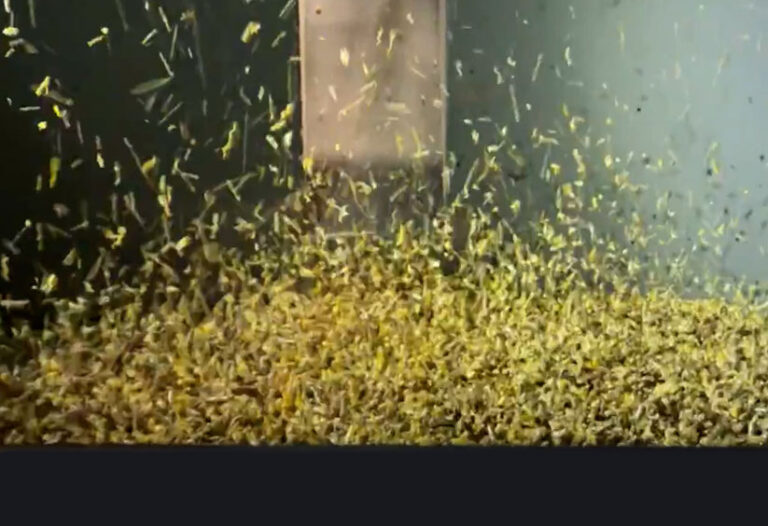Fluid bed dryers offer an efficient and effective means of drying bulk solids for a variety of industries. For facilities considering the use of this industrial dryer, understanding the basic principles behind fluid beds is essential. The following provides a comprehensive overview on the key terms and definitions associated with fluid bed dryer use and operation.
Fluidization
Fluidization refers to the suspension of solids by gas or air in such a way that the solids behave as a liquid. Fluid bed dryers employ fluidization as a means of drying materials.
Minimum Fluidization
Minimum fluidization is the point at which the solids begin to separate and allow for relative movement against each other. At this point, the bed is still fairly static, but does swell, allowing for air flow between particles.
Minimum Fluidization Velocity
The minimum fluidization velocity is the velocity required to achieve minimum fluidization. In other words, it is the minimum rate of air or gas flow (measured in feet per minute/FPM) required to suspend the bed of solids in a fluidized state.
While general guidelines are available, the minimum fluidization velocity for a given source of feedstock varies based on factors such as particle size, moisture content, and more. It is typically determined through testing a representative sample.
In general, however, the greater the moisture content of a material, the higher the required velocity to achieve minimum fluidization.
Terminal Velocity
Terminal velocity is the maximum velocity a particle is capable of reaching at a free fall through the gas stream, given its size, weight, and mass. Once the system has a gas flow through the bed, any particles light or small enough for this velocity to exceed the settling velocity will result in these finer, lighter solids becoming entrained from the bed.
Static (Packed) Bed
A static or packed bed refers to the state of the solids in their resting state and up to minimum fluidization.
Dense Phase
When a bubbling fluidized bed is employed, the term “dense phase” is used to describe the portion of the bed where the solids are concentrated, or in other words, the area toward the bottom of the bed.
Lean Phase (aka Dispersed Phase or Freeboard Region)
In contrast, the lean phase, also known as the freeboard region or dispersed phase, is the area toward the top of the fluidized bed of material and above it, where smaller particles become entrained in the air flow. Within this region, the quantity of solids lessens as bed height increases.
Elutriation
Elutriation is the entrainment of fine particles in the air flow above the bed.
Transport Disengagement Height (TDH)
In the lean phase or freeboard region, the transport disengagement height, or TDH, is the height at which entrained particles will separate, with larger particles returning to the bed, while smaller particles remain entrained.
Knowing where the TDH exists is important during the design stages in locating the gas exit, in order to avoid excessive fines in the off-gas.
Fine Products
Fine products are those that become entrained or elutriated in the gas flow, rising above the bed.
Coarse Products
Coarse products are those that do not become entrained in the air flow, instead remaining within the bed.
This natural separation of coarse and fine products is often employed in dedusting and classification efforts.
Cut Size
While transport disengagement height refers to the column height at which particles will separate, cut size refers to the particle size at which coarse and fine products separate.
Retention Time (aka. Residence Time)
Retention or residence time refers to the period of time the solids are processed in the unit. Optimal retention time, or the time required to reach the desired product specifications, is often determined through batch- and pilot-scale tests such as those conducted in the FEECO Innovation Center.
Gas Distributor Plate
The gas distributor plate is the perforated plate at the bottom of the unit on which solids rest prior to fluidization. This plate evenly distributes the gas or air flow to achieve uniform velocity across the bed.
The gas distributor plate is most often a flat plate with simple engineered holes, but other designs may be employed to incorporate nozzles or tuyers.
Weep
Weep occurs when solids fall through the distributor plate. This may occur because a particle is heavy or large enough that its terminal velocity is above the opposing gas velocity, but more often, weep occurs when a system is shut down with a bed still in place. As the bed collapses, particles fall through the distributor plate. Preventing weep is possible through different approaches.
Bed Voidage
Bed voidage refers to the voids that occur within the bed as gas velocity is increased. As the bed becomes fluidized and swells, bed voidage, or the space between particles, increases, resulting in a bed that is more dispersed. At a lower fluidization, particles are less dispersed (i.e., the bed has less voidage).
Cyclone Separator
A cyclone separator employs centrifugal force to remove fine particles from the off gas as part of the off-gas treatment system.
Continuously Stirred Tank Reactor
A continuously stirred tank reactor, or CSTR, is a type of reactor or vessel in which the materials being processed are continuously agitated.
A fluid bed dryer can be considered a type of continuously stirred tank reactor, because there is a complete mixing of the solids. In other words, both the wettest and driest solids are exposed to the air flow, which greatly increases the efficient use of the available heat.
This also means that a fluid bed dryer should not be considered a plug flow dryer, in which only the coldest, wettest solids are exposed to the hottest gas, though some modified plug flow fluid bed dryers (PFFBD) do exist, but would not be considered a CSTR.
Short Circuiting
Short circuiting is an industry term used to describe when the output contains both fully dried and undried solids.
Pneumatic Dryer
A pneumatic dryer is a dryer in which the sole mover of solids is air flow. Because fluid bed dryers employ air and only air to move material through the unit, they are considered a type of pneumatic dryer.
Vibratory Fluid Bed
Vibratory fluid bed dryers and stationary/static fluid bed dryers are often confused. However, vibratory fluid beds are not true fluid bed dryers, because in addition to fluidization, vibration is employed to assist in moving material through the unit. As mentioned, a true fluid bed dryer is a pneumatic dryer, in which air or gas flow is the only means of moving material through the unit. True stationary fluid bed dryers generally require a smaller footprint than vibratory fluid beds.
Heat Transfer Coefficient
In relation to fluid bed dryers, the heat transfer coefficient refers to the heat transferred (flux) divided by the temperature differential. Heat transfer coefficient is important in system design, informing decisions on temperatures, as well as unit size, volume, and retention time.
System Pressures
Management of pressure through the FB system is critical. The proper design of a system requires careful management of the pressure in three key areas: under the air distribution grid, through the bed, and in the freeboard region above the material bed.
Management of these pressures helps to prevent weep, overcome any material piling in the unit, and prevent a positive or negative air flow from influencing particle movement in the freeboard region, respectively.
Conclusion
Understanding the concepts behind fluid bed dryers is critical to any facility operator interested in taking advantage of this efficient and effective bulk solids dryer.
FEECO is a leading supplier of the industry’s most reputable bulk solids drying equipment. To learn more about our custom fluid bed dryers or testing in our Innovation Center, contact us today.



